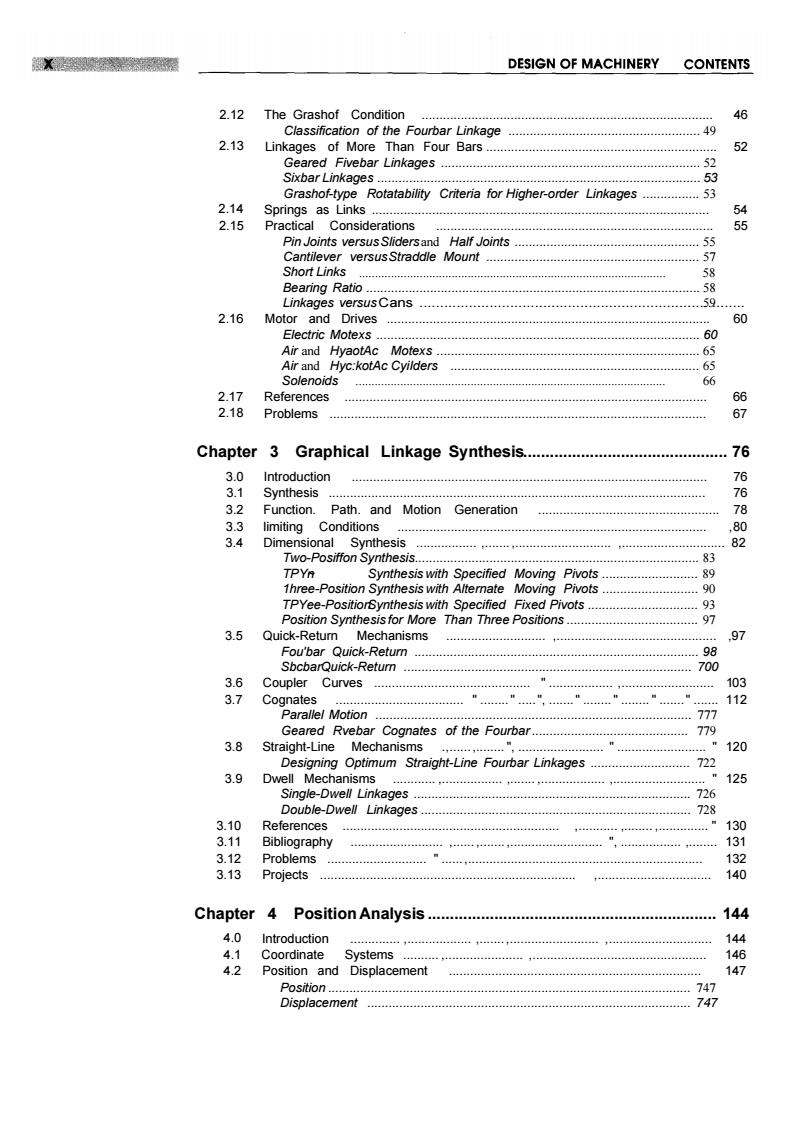正在加载图片...

X DESIGN OF MACHINERY CONTENTS 2.12 The Grashof Condition 46 Classification of the Fourbar Linkage 49 2.13 Linkages of More Than Four Bars..... 52 Geared Fivebar Linkages Sixbar Linkages… 53 Grashof-type Rotatability Criteria for Higher-order Linkages ...............53 2.14 Springs as Links ......... 54 2.15 Practical Considerations 55 Pin Joints versus Slidersand Half Joints 55 Cantilever versus Straddle Mount ...... .57 Short Links 58 Linkages versusCans 59. 2.16 Motor and Drives 60 Electric Motexs 60 Air and HyaotAc Air and Hyc:kotAc Cyilders 65 Solenoids 66 2.17 References 66 2.18 Problems 67 Chapter 3 Graphical Linkage Synthesis..... 76 3.0 Introduction 76 3.1 Synthesis 76 3.2 Function. Path.and Motion Generation 78 3.3 limiting Conditions 80 3.4 Dimensional Synthesis 82 Two-Posiffon Synthesis.83 TPYR Synthesis with Specified Moving Pivots 89 1hree-Position Synthesis with Alternate Moving Pivots...................90 TPYee-PositiorSynthesis with Specified Fixed Pivots... 93 Position Synthesis for More Than Three Positions. 97 3.5 Quick-Retum Mechanisms 97 Fou'bar Quick-Return ......... 98 SbcbarQuick-Return .700 3.6 Coupler Curves 103 3.7 Cognates 112 Parallel Motion.777 Geared Rvebar Cognates of the Fourbar........................ 779 3.8 Straight-Line Mechanisms 120 Designing Optimum Straight-Line Fourbar Linkages ............... 722 3.9 Dwell Mechanisms 125 Single-Dwell Linkages 726 Double-Dwell Linkages...28 3.10 References 130 3.11 Bibliography 131 3.12 Problems 132 3.13 Projects 140 Chapter 4 Position Analysis 144 4.0 Introduction 144 4.1 Coordinate Systems 146 4.2 Position and Displacement 147 Position ....... 747 Displacement 7472.12 The Grashof Condition .................................................................................. 46 Classification of the Fourbar Linkage ...................................................... 49 2.13 Linkages of More Than Four Bars ................................................................. 52 Geared Fivebar Linkages ......................................................................... 52 Sixbar Linkages ........................................................................................... 53 Grashof-type Rotatability Criteria for Higher-order Linkages ................ 53 2.14 Springs as Links ............................................................................................... 54 2.15 Practical Considerations .............................................................................. 55 Pin Joints versusSlidersand Half Joints .................................................... 55 Cantilever versusStraddle Mount ............................................................ 57 Short Links ................................................................................................ 58 Bearing Ratio .............................................................................................. 58 Linkages versusCans ............................................................................... 59 2.16 Motor and Drives ........................................................................................... 60 Electric Motexs ........................................................................................... 60 Air and HyaotAc Motexs .......................................................................... 65 Air and Hyc:kotAc CyiIders ...................................................................... 65 Solenoids ................................................................................................. 66 2.17 References ...................................................................................................... 66 2.18 Problems .......................................................................................................... 67 Chapter 3 Graphical Linkage Synthesis.............................................. 76 3.0 Introduction .................................................................................................... 76 3.1 Synthesis .......................................................................................................... 76 3.2 Function. Path. and Motion Generation ................................................... 78 3.3 limiting Conditions ....................................................................................... ,80 3.4 Dimensional Synthesis ................. ,.......,........................... ,............................. 82 Two-Posiffon Synthesis................................................................................ 83 TPY~n Synthesis with Specified Moving Pivots ........................... 89 1hree-Position Synthesis with Alternate Moving Pivots ........................... 90 TPYee-PositionSynthesis with Specified Fixed Pivots ............................... 93 Position Synthesis for More Than Three Positions ..................................... 97 3.5 Quick-Return Mechanisms ............................ ,............................................. ,97 Fou'bar Quick-Return ................................................................................ 98 SbcbarQuick-Return ................................................................................. 700 3.6 Coupler Curves ............................................ " .................. ,.......................... 103 3.7 Cognates .................................... " ........" .....", ......." ........" ........" ......." ....... 112 Parallel Motion ......................................................................................... 777 Geared Rvebar Cognates of the Fourbar ............................................ 779 3.8 Straight-Line Mechanisms .,......,........", ........................ " ......................... " 120 Designing Optimum Straight-Line Fourbar Linkages ............................ 722 3.9 Dwell Mechanisms ............ ,................. ,....... ,.................. ,.......................... " 125 Single-Dwell Linkages .............................................................................. 726 Double-Dwell Linkages ............................................................................ 728 3.10 References ............................................................. ,........... ,........ ,.............. " 130 3.11 Bibliography .......................... ,......,.......,.......................... ", ................. ,........ 131 3.12 Problems ............................ " ......,.................................................................. 132 3.13 Projects ........................................................................ ,................................ 140 Chapter 4 Position Analysis................................................................. 144 4.0 Introduction .............. ,.................. ,.......,......................... ,............................. 144 4.1 Coordinate Systems .......... ,...................... ,................................................. 146 4.2 Position and Displacement ....................................................................... 147 Position ...................................................................................................... 747 Displacement ........................................................................................... 747